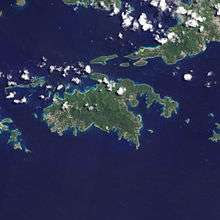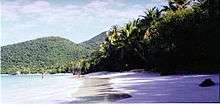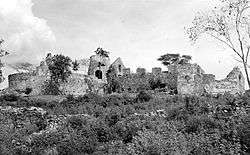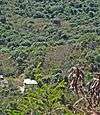Saint John, U.S. Virgin Islands
| Nickname: Love City | |
|---|---|
 Saint John, U.S. Virgin Islands | |
| Geography | |
| Location | Caribbean Sea |
| Coordinates | 18°20′N 64°44′W / 18.333°N 64.733°WCoordinates: 18°20′N 64°44′W / 18.333°N 64.733°W |
| Archipelago | Virgin Islands, Leeward Islands |
| Area | 19.61 sq mi (50.8 km2) |
| Country | |
|
United States | |
| Insular area | United States Virgin Islands |
| District | Saint John |
| Largest settlement | Cruz Bay (pop. 2,706) |
| Demographics | |
| Population | 4,170 (as of 2010) |
| Density | 82.09 /km2 (212.61 /sq mi) |



Saint John (Spanish: San Juan ; Dutch: Sint Hans; French: Saint-Jean ; Danish: Sankt Jan) is one of the Virgin Islands in the Caribbean Sea and a constituent district of the United States Virgin Islands (USVI), an unincorporated territory of the United States.
The smallest of the main US islands besides Water Island, Saint John is located about four miles east of Saint Thomas, the location of the territory's capital, Charlotte Amalie. It is four miles southwest of Tortola, part of the British Virgin Islands.
A ferry service runs hourly from St. Thomas and daily from Tortola; regular ferries also operate from Virgin Gorda, Jost Van Dyke and Anegada.
Since 1956, approximately 60% of the island is protected as Virgin Islands National Park, administered by the United States National Park Service. The economy is based on tourism.
Overview
Currently, Saint John is 50.8 km² (19.61 sq mi) in area with a population of 4,170 (2010 census).[1] As of the 2010 U.S. Census, the total population of the US Virgin Islands territory was 106,405,[2] comprising mostly persons of Afro-Caribbean descent.[1][2]
History
Saint John was first settled by Arawak Indians who migrated north from coastal areas of present-day Colombia and Venezuela around AD 300. The Arawak inhabited the island until around the year AD 1300, when they were driven off by the more aggressive and warlike Carib.
Extensive archaeological work has been undertaken from 1996 to the present at Cinnamon Bay. The artifacts from this dig are being studied and are expected to yield more detailed information on pre-Columbian civilization in the US Virgin Islands.
Explorer Christopher Columbus, traveling on behalf of the Spanish Crown, is credited with being the first European to see the Virgin Islands in 1493, during his second voyage to the New World. A Catholic, he named the group of numerous islands as Once Mil Virgenes (Eleven Thousand Virgins), in honor of the feast day of Saint Ursula and the 11,000 virgins who were martyred with her.
-

Gibney Beach on Hawksnest Bay, near home once owned by J. Robert Oppenheimer.
-

Sunset at Caneel Bay
-

Wild donkeys at Caneel Bay
-

Turtle Bay Beach at Caneel Bay
-

Sunset at Turtle Bay
-

Reef Bay and Virgin Islands National Park from Cocoloba Point.
-

Trunk Bay Beach
-

Trunk Bay
-

Virgin Islands National Park Building Saint John
-

Near Caneel Bay Saint John, U.S. Virgin Islands
-

Beautiful Scenery Saint John, U.S. Virgin Islands
-

Ruines
Territory
Since 1917, the U.S. Virgin Islands are an organized, unincorporated territory of the United States. Its residents are U.S. citizens, but they cannot vote in presidential elections.
Colonization and settlement
The Danish West India and Guinea Company represented the first Europeans to settle the island in 1718. They are also credited with naming the island Saint John (Danish: Sankt Jan). The Danish crown took full control of this and nearby colonies in 1754, including those founded on the similarly named islands of Saint Thomas and Saint Croix.
Sugar cane plantations, such as the famous Annaberg Sugar Plantation, were established in great numbers on Saint John; the intense heat and fertile soil provided ideal growing conditions. The establishment of sugarcane plantationss created a high demand for labor. The indigenous Carib and Arawak were used as slave labor but their population was quickly decimated by new infectious diseases.
The planters imported many slaves from Africa in an established slave trade dominated by Portugal in the early years, but which Britain also entered. In 1733 Saint John was the site of one of the first significant slave rebellions in the New World. Enslaved Akwamu from the Gold Coast rebelled and took control of the island for six months before being defeated by a combination of better armed forces.
The Danish defeated the enslaved Africans with help from French colonists of Martinique. Instead of submitting to captivity and slavery, more than a dozen men and women shot and killed themselves before the French forces reached them. It is estimated that by 1775, slaves outnumbered the Danish settlers on Saint John by a ratio of 5:1. Denmark finally abolished slavery in Saint John and its other islands on July 3, 1848.
Purchase

In 1917, during the Great War, the United States purchased the U.S. Virgin Islands for $25 million from the Danish government in order to establish a naval base. It was intended to prevent expansion of the German Empire in the Western Hemisphere. As part of the negotiations for this deal, the US agreed to recognize Denmark's claim to Greenland, which they had previously disputed.
During the 20th century, private investors acquired properties on the island, redeveloping some plantation houses as vacation resorts, such as Laurence Rockefeller's Caneel Bay Resort. The islands became popular and tourism and related service jobs developed as a major part of the economy.
Present governance
Until 1970, governors of the territory were appointed by the US President. Since that year, residents of the island have elected a territorial governor and lieutenant governor, and fifteen senators to the legislature, representing all three islands. Seven are elected from the district of Saint Croix, seven from the district of Saint Thomas and Saint John, and one senator at-large (who must be a resident of Saint John) are elected for two-year terms to the unicameral Virgin Islands Legislature.
Residents of the Virgin Islands also elect a delegate to the US Congress, who has non-voting status in that body.
Saint John has no local government; however, the Governor appoints an administrator for the island. Having no official powers, this figure acts more as an adviser to the Governor and as a spokesperson for the Governor's policies.
The main political parties in the U.S. Virgin Islands are the Democratic Party of the Virgin Islands, the Independent Citizens Movement (ICM), and the Republican Party of the Virgin Islands. Additional candidates run as independents.
Virgin Islands National Park
In 1956, Laurance Rockefeller donated his extensive lands on the island to the United States' National Park Service, under the condition that the lands had to be protected from future development. The remaining portion, the Caneel Bay Resort, operates on a lease arrangement with the NPS, which owns the underlying land.
The boundaries of the Virgin Islands National Park include 75% of the island, but various in-holdings within the park boundary (e.g., Peter Bay, Maho Bay) reduce the park lands to 60% of the island acreage.
Much of the island's waters, coral reefs, and shoreline have been protected by being included in the national park. This protection was expanded in 2001, when the Virgin Islands Coral Reef National Monument was created.
Voting

Saint John is divided into the following subdistricts (with population as per the 2010 U.S. Census):
Activists filed a lawsuit on September 20, 2011 in the federal US District Court of the Virgin Islands seeking the right to be represented in Congress and to vote for U.S. President. The case is Civil No. 3:11-cv-110, Charles v. U.S. Federal Elections Commission et al. The case alleges the 1917 Congress, with all-white members, denied the right to vote to island residents due to racial discrimination, as the island had a majority of people of color. The case was dismissed on August 20, 2012.[3]
Historic landmarks
| [4] | Name on the Register | Image | Date listed[5] | Location | City or town | Description |
|---|---|---|---|---|---|---|
| 1 | Annaberg Historic District |  |
(#81000090) |
Northwest of Coral Bay, Leinster Bay 18°21′53″N 64°44′18″W / 18.364722°N 64.738333°W |
Central | |
| 2 | Brown Bay Plantation Historic District | Upload image | (#81000089) |
North of Palestina 18°21′47″N 64°42′25″W / 18.363056°N 64.707083°W |
Central | Virgin Islands National Park MRA |
| 3 | Catherineberg-Jockumsdahl-Herman Farm |  |
(#78000270) |
East of Cruz Bay 18°20′49″N 64°45′39″W / 18.346944°N 64.760833°W |
Central | Virgin Islands National Park MRA |
| 4 | Cinnamon Bay Plantation |  |
(#78000269) |
Northeast of Cruz Bay on Cinnamon Bay 18°21′15″N 64°45′15″W / 18.354167°N 64.754167°W |
Central | Virgin Islands National Park MRA |
| 5 | Congo Cay Archeological District | Upload image | (#78003166) |
Address Restricted |
Cruz Bay | Virgin Islands National Park MRA |
| 6 | Dennis Bay Historic District |  |
(#81000095) |
Northeast of Cruz Bay off North Shore Road 18°21′15″N 64°46′33″W / 18.354167°N 64.775833°W |
Central | Virgin Islands National Park MRA |
| 7 | Emmaus Moravian Church and Manse |  |
(#77001531) |
West of Palestina 18°21′01″N 64°42′48″W / 18.350278°N 64.713333°W |
Coral Bay | |
| 8 | Enighed | Upload image | (#76002219) |
Cruz Bay Quarter 18°19′54″N 64°47′30″W / 18.331667°N 64.791667°W |
Cruz Bay | |
| 9 | Estate Beverhoudt | Upload image | (#78003170) |
1.5 miles (2.4 km) east of Cruz Bay off Center Line Road 18°20′27″N 64°46′19″W / 18.340833°N 64.771944°W |
Central | |
| 10 | Estate Carolina Sugar Plantation |  |
(#76002217) |
West of Coral Bay on King Hill Road 18°20′58″N 64°43′07″W / 18.349444°N 64.718611°W |
Coral Bay | |
| 11 | Fortsberg |  |
(#76002218) |
Southeast of Coral Bay 18°20′45″N 64°42′20″W / 18.345833°N 64.705556°W |
Coral Bay | |
| 12 | Hermitage Plantation Historic District | Upload image | (#81000094) |
East End Road, Hurricane Hole 18°21′32″N 64°41′59″W / 18.358889°N 64.699722°W |
Central | Virgin Islands National Park MRA |
| 13 | HMS Santa Monica | Upload image | (#78003163) |
Address Restricted |
Coral Bay | |
| 14 | Jossie Gut Historic District | Upload image | (#81000086) |
West of Coral Bay off Center Line Road, Reef Bay 18°20′32″N 64°44′25″W / 18.342222°N 64.740278°W |
Central | Virgin Islands National Park MRA |
| 15 | L'Esperance Historic District | Upload image | (#81000699) |
East of Cruz Bay off Center Line Road, Reef Bay 18°20′33″N 64°45′30″W / 18.3425°N 64.758333°W |
Central | Virgin Islands National Park MRA |
| 16 | Lameshur Plantation | Upload image | (#78000271) |
East of Cruz Bay on Little Lameshur Bay 18°20′33″N 64°45′30″W / 18.3425°N 64.758333°W |
Central | Virgin Islands National Park MRA |
| 17 | Liever Marches Bay Historic District | Upload image | (#81000087) |
East of Brown Bay 18°21′16″N 64°42′04″W / 18.354444°N 64.701111°W |
Central | Virgin Islands National Park MRA |
| 18 | Lind Point Fort | |
(#81000085) |
Northwest of Cruz Bay 18°20′13″N 64°47′50″W / 18.336944°N 64.797222°W |
Central | Virgin Islands National Park MRA |
| 19 | Mary Point Estate |  |
(#78000272) |
Northeast of Cruz Bay 18°22′06″N 64°44′29″W / 18.368333°N 64.741389°W |
Central | Virgin Islands National Park MRA |
| 20 | More Hill Historic District | Upload image | (#81000092) |
Off East End Road 18°21′40″N 64°41′37″W / 18.361111°N 64.693611°W |
East End | Virgin Islands National Park MRA |
| 21 | Petroglyph Site |  |
(#82001716) |
Reef Bay Coordinates missing |
Central | |
| 22 | Reef Bay Great House Historic District | Upload image | (#81000091) |
West of Bordeaux, Reef Bay 18°19′55″N 64°44′23″W / 18.332083°N 64.739722°W |
Central | Virgin Islands National Park MRA |
| 23 | Reef Bay Sugar Factory Historic District |  |
(#81000084) |
East of Cruz Bay, Reef Bay 18°19′31″N 64°44′40″W / 18.325278°N 64.744444°W |
Central | Virgin Islands National Park MRA |
| 24 | Rustenberg Plantation South Historic District | Upload image | (#81000093) |
West of Coral Bay off Center Line Road, Cinnamon Bay 18°20′42″N 64°44′59″W / 18.345°N 64.749722°W |
Central | Virgin Islands National Park MRA |
| 25 | Trunk Bay Sugar Factory | Upload image | (#81000088) |
Northeast of Cruz Bay on North Shore Road, Trunk Bay 18°21′35″N 64°46′02″W / 18.359861°N 64.767222°W |
Central | Virgin Islands National Park MRA |
Economy

The main export of Saint John used to be sugar cane, which was produced in great quantity using African and Indian slave labor. However, this industry declined after the abolition of slavery, when it became dependent on free labor. In addition, in that period, it had to compete with sugar produced in other areas, including by the use of sugar beets in northern locations.
The economy of Saint John is now almost entirely founded on tourism and tourism-related industries, real estate development, guest houses, and hotels.
The waters surrounding the US Virgin Islands are patrolled by United States Coast Guard cutters out of Miami, Florida, and San Juan, Puerto Rico.
Historical air service
While St. John doesn't have an airport, there is a seaplane base[6][7] in the town of Cruz Bay although there is no scheduled airline service. Antilles Airboats provided regular service until it was sold by Maureen O'Hara.[8] The Virgin Islands Seaplane Shuttle used to offer services to that seaplane base using Grumman Mallard air boats prior to Hurricane Hugo.[9]
Major port-town
Cruz Bay has become the principal town on the island as it has the landing for the ferry service from St. Thomas, which became the main route of entry to the island. Previously, Coral Bay was the hub of economic activity on the island.
Its natural port offered protection to the sailing ships of the day. In addition, it was an easy sail by smaller boats, with minimal tacking, to the nearby British Virgin Islands. Until the late 20th century, the residents of Coral Bay and East End had easier and more frequent access to Tortola than did those of either Cruz Bay or St. Thomas.
According to the 2010 U.S. Census, Saint John has a resident population of 4,170 people, most of whom live in either Cruz Bay or Coral Bay on the eastern end of the island. However, being a U.S. territory, its population is not included in the overall U.S. population count.
Education
St. Thomas-St. John School District operates schools for the island residents. Saint John has one public school, Julius E. Sprauve (JESS). Private and parochial schools include Gift Hill School (formerly Pine Peace and Coral Bay), Saint John Christian Academy, Saint John Methodist School, and the Saint John Montessori School.
The only school that includes a high school is Gift Hill, along with their programs in elementary and middle school. The only other middle school on the island is at 'JESS,' which also has an elementary program. Other schools are either age 3-3rd grade or k5-6th grade.
Fiction
- In John Grisham's novel The Pelican Brief, the heroes escape to Saint John: specifically, a small cottage in Maho Bay, along the North Shore.
- Hawksnest Bay was the filming location for the Alien beach scene towards the end of the movie Contact.
- Grandma Raised the Roof by Ethel Walbridge McCully. Author's own story of building her dream home on St. John's VI and defending it from being acquired by the National Park Service, in the early 1950s.[10]
See also
- Flanagan Island
- Great Thatch
- Norman Island
- Piracy in the British Virgin Islands
- Virgin Islands Coral Reef National Monument
- List of people from the United States Virgin Islands
- Outline of the United States Virgin Islands
- Index of United States Virgin Islands-related articles
- Bibliography of the United States Virgin Islands
- National Register of Historic Places listings in the United States Virgin Islands
References
- 1 2 "2010 Census U.S. Virgin Islands, United States Census Bureau". Retrieved October 4, 2012.
- 1 2 2010 Population Counts for the U.S. Virgin Islands, U.S. Census Bureau.
- ↑ Charles v. U.S. Federal Election Commission et al, Docket Alarm, 2012-2015
- ↑ Numbers represent an ordering by significant words. Various colorings, defined here, differentiate National Historic Landmarks and historic districts from other NRHP buildings, structures, sites or objects.
- ↑ The eight-digit number below each date is the number assigned to each location in the National Register Information System database, which can be viewed by clicking the number.
- ↑ http://airportsbase.org/Virgin_Islands/all/St_John_Island/Cruz_Bay_Seaplane_Base
- ↑ http://ourairports.com/airports/SJF/#lat=18.3315,lon=-64.79599999999999,zoom=14,type=Satellite,airport=SJF Cruz Bay Seaplane Base-OurAirports
- ↑ http://virginislandsdailynews.com/news/maureen-o-hara-left-mark-in-virgin-islands-1.1962940
- ↑ http://capnaux.blogspot.com/2012/11/hurricane-hugo-part-2.html
- ↑ "ETHEL MCCULLY, SAVED VIRGIN ISLANDS HOME FROM CONDEMNATION". NYTimes.com. January 4, 1981. Retrieved November 4, 2015.
Ethel Walbridge McCully, the grandmother who went to Washington to ''raise a little hell'' on Capitol Hill in 1962, died Dec. 21 on St. John in the Virgin Islands in the home she successfully defended against condemnation by the National Park Service. She was 94 years old. Mrs. McCully was a secretary in New York City in 1947 when, on one of her frequent trips to the Caribbean, she first saw the island of St. John. She swam ashore with a basketful of belongings because the captain of her English cruise ship declined to dock at the then undeveloped island. Mrs. McCully, a small, outspoken woman, bought four acres, designed her dream house and spent 11 years struggling with suppliers, boat captains and workmen to build it. She described her tribulations in a book entitled Grandma Raised the Roof. Her home, called Island Fancy, was jeopardized in 1962 by a clause in a Congressional bill calling for the enlargement of the Virgin Islands National Park. The clause would have let the National Park Service acquire land on the island by condemnation. With other island homeowners, Mrs. McCully lobbied to get the provision struck from the bill. Some years ago, Mrs. McCully reluctantly sold the house to the Park Service with the proviso that she would have life tenancy.
- St. John Tradewinds - Major Saint John Newspaper, Est. 1972
- Rankin, D.W. (2002). Geology of St. John, U.S. Virgin Islands [U.S. Geological Survey Professional Paper 1631]. Washington, D.C.: U.S. Department of the Interior, U.S. Geological Survey.
- 36 Hours in St. John – 2006 New York Times article by Jon Rust
- Why I Gave Up a $95,000 Job to Move to an Island and Scoop Ice Cream - 2015 Cosmopolitan article by Noelle Hancock
- Checklist: St. John, U.S. Virgin Islands - Stephanie Burt, Paste Magazine
- House Hunting on ... St. John - Marcelle S. Fischler, New York Times
External links
| Wikimedia Commons has media related to Saint John, United States Virgin Islands. |
| Wikisource has the text of a 1911 Encyclopædia Britannica article about Saint John. |
-
 Saint John, United States Virgin Islands travel guide from Wikivoyage
Saint John, United States Virgin Islands travel guide from Wikivoyage - Census 2000 Data for the U.S. Virgin Islands
- News of St. John, Saint John Blog
- St. John Interactive Map
| ||||||||||||||||||||||||||
